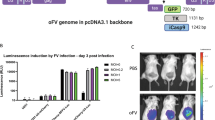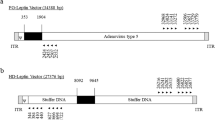Abstract
To confer adenovirus vectors (AdV), the feature of integration into the host cell genome hybrid vectors were characterized in vitro, which express vectors derived from the prototypic foamy virus (FV) in the backbone of a high-capacity AdV. FVs constitute a subfamily of retroviruses with a distinct replication pathway and no known pathogenicity. In the absence of envelope glycoprotein, the prototypic FV behaves like a retrotransposon, while it behaves like an exogenous retrovirus in its presence. Two principle types of vectors, which either allows the intracellular (HC-FAD-7) or, in addition, the extracellular (HC-FAD-2) pathway were constructed. In both chimeras the expression of the FV vector was controlled by the tetracycline-regulatable system. Hybrids were produced close to 1010 infectious units/ml. By Southern blotting, the functionality of the hybrid vectors to generate host cell genomic integrants was shown. However, the efficiency of HC-FAD-7 to establish stable transgene expression was rather low, while around 70% of cells were stably transduced in secondary round following primary transduction with HC-FAD-2 at an MOI of 100. Given the benign characteristics of high-capacity adenovirus and FV vectors, hybrids based on HC-FAD-2 are probably suited for an in vivo application.
This is a preview of subscription content, access via your institution
Access options
Subscribe to this journal
Receive 12 print issues and online access
$259.00 per year
only $21.58 per issue
Buy this article
- Purchase on Springer Link
- Instant access to full article PDF
Prices may be subject to local taxes which are calculated during checkout







Similar content being viewed by others
References
Verma IM, Somia N . Gene therapy. Nature 1997; 389: 239–242.
Blau H, Khavari P . Gene therapy: progress, problems, prospects. Nat Med 1997; 3: 612–613.
Kochanek S et al. A new adenoviral vector: replacement of all viral coding sequences with 28 kb of DNA independently expressing both full-length dystrophin and β-galactosidase. Proc Natl Acad Sci (USA) 1996; 93: 5731–5736.
Kreppel F et al. Long-term transgene expression in the RPE after gene transfer with a high-capacity adenoviral vector. Invest Ophthamol Vis Sci 2002; 43: 1965–1970.
Schiedner G et al. Genomic DNA transfer with a high-capacity adenovirus vector results in improved in vivo gene expression and decreased toxicity. Nat Genet 1998; 18: 180–183.
ICTV. The International Committee on Taxonomy of Viruses. see: http://www.danforthcenter.org/iltab/ICTVnet〉 2002.
Linial ML . Foamy viruses are unconventional retroviruses. J Virol 1999; 73: 1747–1755.
Rethwilm A . The replication strategy of foamy viruses. Curr Top Microbiol Immunol 2003; 277: 1–26.
Heinkelein M et al. Improved primate foamy virus vectors and packaging constructs. J Virol 2002; 76: 3774–3783.
Trobridge G et al. Improved foamy virus vectors with minimal viral sequences. Mol Ther 2002; 6: 321–328.
Heinkelein M et al. Efficient intracellular retrotransposition of an exogenous primate retrovirus genome. EMBO J 2000; 19: 3436–3445.
Baunach G et al. Functional analysis of human foamy virus accessory reading frames. J Virol 1993; 67: 5411–5418.
Erlwein O, Rethwilm A . BEL-1 transactivator responsive sequences in the long terminal repeat of human foamy virus. Virology 1993; 196: 256–268.
Keller A et al. Characterization of the transcriptional transactivator of human foamy retrovirus. J Virol 1991; 65: 2589–2594.
Rethwilm A et al. The transcriptional transactivator of human foamy virus maps to the bel 1 genomic region. Proc Natl Acad Sci USA 1991; 88: 941–945.
Fischer N et al. Foamy virus particle formation. J Virol 1998; 72: 1610–1615.
Pietschmann T et al. Foamy virus capsids require the cognate envelope protein for particle export. J Virol 1999; 73: 2613–2621.
Yu SF et al. Human foamy virus replication: a pathway distinct from that of retroviruses and hepadenoviruses. Science 1996; 271: 1579–1582.
Enssle J, Jordan I, Mauer B, Rethwilm A . Foamy virus reverse transcriptase is expressed independently from the Gag protein. Proc Natl Acad Sci USA 1996; 93: 4137–4141.
Kreppel F, Biermann V, Kochanek S, Schiedner G . A DNA-based method to assay total and infectious particle contents and helper virus contamination in high-capacity adenoviral vector preparations. Hum Gene Ther 2002; 13: 1151–1156.
Dinser R et al. Comparison of long-term transgene expression after non-viral and adenoviral gene transfer into primary articular chondrocytes. Histochem Cell Biol 2001; 116: 69–77.
Hahn H et al. Reactivity of primate sera to foamy virus gag and bet proteins. J Gen Virol 1994; 75: 2635–2644.
Lindemann D et al. A particle-associated glycoprotein signal peptide essential for virus maturation and infectivity. J Virol 2001; 75: 5762–5771.
Mitani K, Kubo S . Adenovirus as an integrating vector. Curr Gene Ther 2002; 2: 135–144.
Bilbao G et al. Adenoviral/retroviral vector chimeras: a novel strategy to achieve high-efficiency stable transduction in vivo. FASEB J 1997; 11: 624–634.
Caplen NJ et al. Adeno-retroviral chimeric viruses as in vivo transducing agents. Gene Therapy 1999; 6: 454–459.
Feng M et al. Stable in vivo gene transduction via a novel adenoviral/retroviral chimeric vector. Nat Biotechnol 1997; 15: 866–870.
Soifer H et al. A novel, helper-dependent, adenovirus–retrovirus hybrid vector: stable transduction by a two-stage mechanism. Mol Ther 2002; 5: 599–608.
Lindemann D, Goepfert PA . The foamy virus envelope glycoproteins. Curr Top Microbiol Immunol 2003; 277: 111–129.
Josephson NC et al. Transduction of human NOD/SCID-repopulating cells with both lymphoid and myeloid potential by foamy virus vectors. Proc Natl Acad Sci USA 2002; 99: 8295–8300.
Leurs C et al. Comparison of three retroviral vector systems for transduction of NOD/SCID repopulating CD34* cord blood cells. Hum Gene Ther 2003; 14: 509–514.
Falcone V, Schweizer M, Neumann-Haefelin D . Replication of primate foamy viruses in natural and experimental hosts. Curr Top Microbiol Immunol 2003; 277: 161–180.
Heneine W, Schweizer M, Sandstrom P, Folks T . Human infection with foamy viruses. Curr Top Microbiol Immunol 2003; 277: 181–196.
Ausubel FM et al. Current Protocols in Molecular Biology. John Wiley: New York, NY, 1987.
Sambrook J, Russell DW . Molecular Cloning: A Laboratory Manual. Cold Spring Harbor Laboratory Press: Cold Spring Harbor, NY, 2001.
Heinkelein M et al. Intracellular retrotransposition and cell-to-cell transfer of foamy viruses. J Virol 2003; 77: 11855–11858.
Gossen M et al. Transcriptional activation by tetracyclines in mammalian cells. Science 1995; 268: 1766–1769.
Gossen M, Bujard H . Tight control of gene expression in mammalian cells by tetracycline-responsive promoters. Proc Natl Acad Sci USA 1992; 89: 5547–5551.
Parks RJ et al. A helper-dependent adenovirus vector system: removal of helper virus by Cre-mediated excision of the viral packaging signal. Proc Natl Acad Sci USA 1996; 93: 13565–13570.
Heinkelein M et al. Pregenomic RNA is required for efficient incorporation of pol polyprotein into foamy virus capsids. J Virol 2002; 76: 10069–10073.
Imrich H, Heinkelein M, Herchenröder O, Rethwilm A . Primate foamy virus pol porteins are inported into the nucleus. J Gen Virol 2000; 81: 2941–2947.
Acknowledgements
This work was supported by grants from the BMBF (BEO 0312191), Sächsisches Staatsministerium für Umwelt und Landwirtschaft (66-8802.5327/62 and 13-8811.61/142), DFG (Re 627/6-3 and Europäisches Graduiertenkolleg ‘Gene regulation in and by microbial pathogens’) Bayerische Forschungsstiftung (Forgen), and EU (BMH4-CT97-2010). FK was supported by the Boehringer Ingelheim Foundation. We thank Frank Graham for providing the helper virus AdLC8cluc.
Author information
Authors and Affiliations
Rights and permissions
About this article
Cite this article
Picard-Maureau, M., Kreppel, F., Lindemann, D. et al. Foamy virus–adenovirus hybrid vectors. Gene Ther 11, 722–728 (2004). https://doi.org/10.1038/sj.gt.3302216
Received:
Accepted:
Published:
Issue Date:
DOI: https://doi.org/10.1038/sj.gt.3302216
Keywords
This article is cited by
-
Molecular biology of foamy viruses
Medical Microbiology and Immunology (2010)
-
Foamy virus: an available vector for gene transfer in neural cells and other nondividing cells
Journal of NeuroVirology (2010)
-
A rapid protocol for construction and production of high-capacity adenoviral vectors
Nature Protocols (2009)
-
Short-term Correction of Arginase Deficiency in a Neonatal Murine Model With a Helper-dependent Adenoviral Vector
Molecular Therapy (2009)
-
Somatic Integration From an Adenoviral Hybrid Vector into a Hot Spot in Mouse Liver Results in Persistent Transgene Expression Levels In Vivo
Molecular Therapy (2007)



